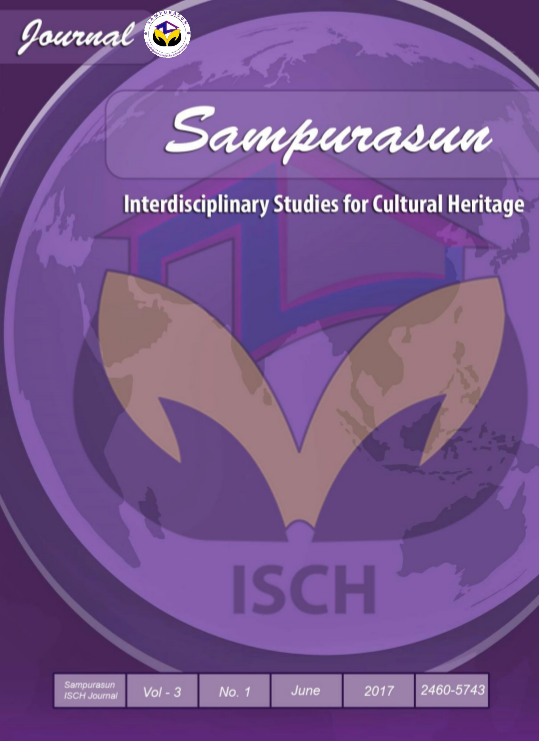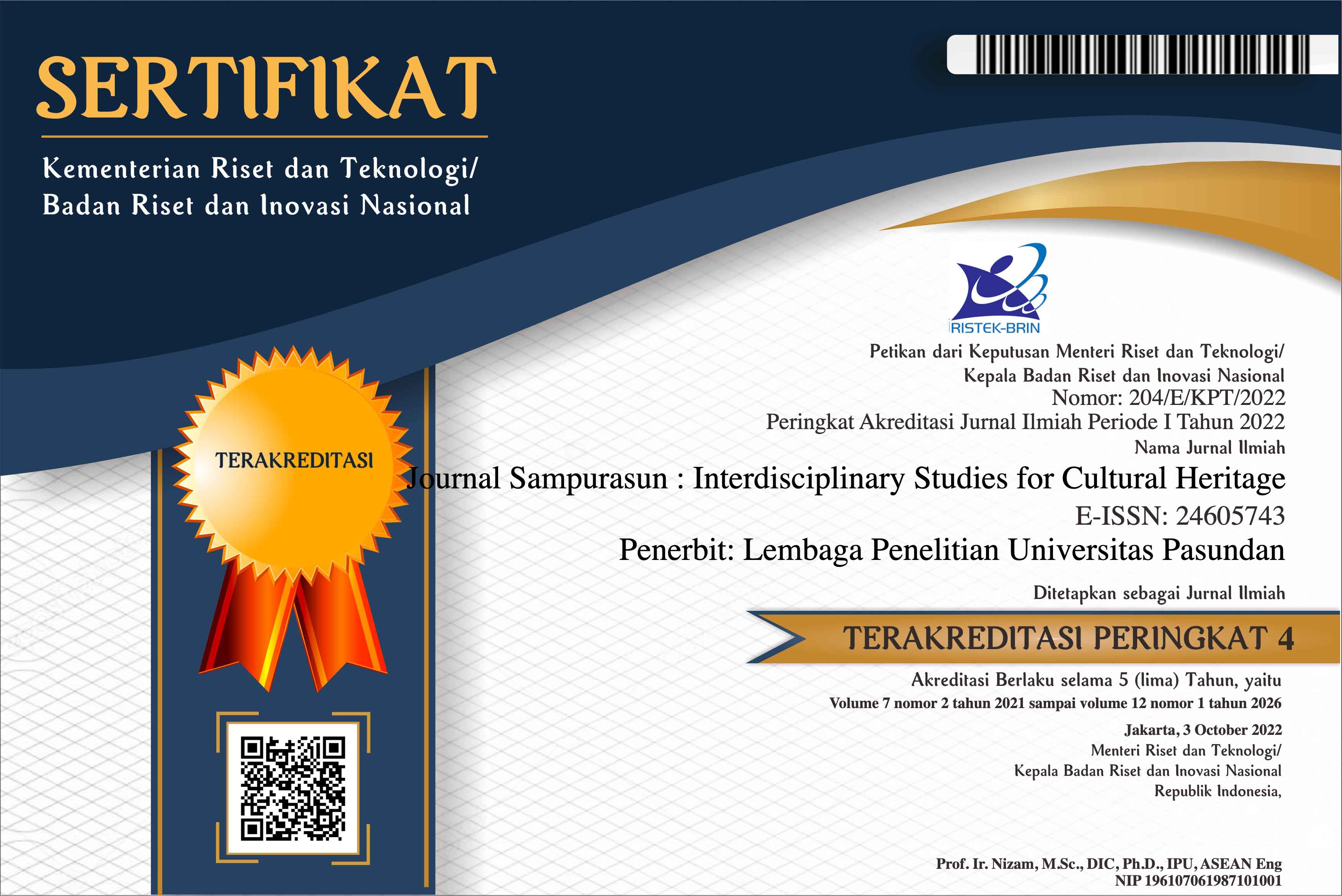DEFINITIONS OF VIOLENCE AGAINST WIVES AMONG INDONESIAN SOCIAL WORK COLLEGE STUDENTS
DOI:
https://doi.org/10.23969/sampurasun.v3i1.343Keywords:
attitudes, college students, definitions violence against wives, socio-cultural factors, socio-demographic factorsAbstract
Violence against wives is the most common form of violence against women reported in Indonesia. Understanding the definition of violence against wives is one of first steps to address the problem given that recognition about what constitutes violent behaviors has an influence on how society responds to victims and perpetrators.
The study described and examined factors associated with the attitudes of Muslim undergraduate social welfare students toward definitions of violence against wives using socio-demographic and socio-cultural perspectives. Samples were selected non-randomly using convenience sampling techniques. Data were collected through a self-administered survey taken by 275 students in the social welfare department of two separate universities located in the provinces of Yogyakarta and East Java late 2016. Data was analyzed using hierarchical regressions techniques.
The study found that students generally reported stronger agreement to viewing physical violence as a form of violence against wives. On the contrary, they were less likely to view non-physical violence as violent behavior. Gender, attitudes toward gender roles, and type of university were found to be associated with attitudes toward the definition of violence against wives. Implications from the findings were discussed, taking into account the roles of educational institutions in shaping the students’ attitudes.
Downloads
References
Antai, D. (2011). Controlling behavior, power relations within intimate relationships and intimate partner physical and sexual violence against women in Nigeria. BMC Public Health, 11, 511-522.
Baldwin-White, A. & Elias-Lambert, N. (2016). Rape myth acceptance among social work students. Journal of Aggression, Maltreatment & Trauma, 25 (7), 702-720.
Ellsberg M. C., Jansen H., Heise L., Watts C. H., Garcia-Moreno C. (2008). Intimate partner violence and women’s physical and mental health in the WHO multi-country study on women’s health and domestic violence: An observational study. The Lancet, 371, 1165-1172. doi:10.1016/s0140-6736(08)60522
Garcia-Moreno C., Jansen H., Ellsberg M., Heise L., Watts C. H. (2006). Prevalence of intimate partner violence: Findings from the WHO multi-country study on women’s health and domestic violence. The Lancet, 368, 1260-1269
Fawole, O.I. (2008). Economic violence to women and girls. Is it receiving the necessary attention?. Trauma, Violence & Abuse, 9 (3), 167-177.
Flood, M. & Pease, B. (2009). Factors influencing attitudes to violence against women. Trauma, Violence & Abuse, 10 (2), 125-142.
Goldblatt, H. (2009). Caring for abused women: impact on nurses’ professionals and personal life experiences. Journal of Advanced Nursing 65 (81), 1645-1654.
Haj-Yahia, M.M. (1998). Beliefs about wife beating among Palestinian women: The Influence of their patriarchal ideology. Violence Against Women, 4, 533-558.
Haj-Yahia, M.M. & Schiff, M. (2007). Definitions of and beliefs about wife abuse among undergraduate students of social work. International Journal of Offender Therapy & Comparative Criminology, 51, 170-189.
Hakimi, M., Hayati, E.E., Marlinawati, V.U., and Ellsberg, M.C.. (2001). (Ed.). Silence for the sake of harmony: Domestic violence and women’s health in Central Java, Indonesia. Yogyakarta, Indonesia: CHN-RL GMU.
Hayati, E.N., Hogberg, U., Hakimi, M., Ellsberg, M.C., & Emmelin, M. (2011). Behind the silence of harmony: Risk factor for physical and sexual violence among women in rural Indonesia. BMC Women’s Health, 11.
Helmreich‚ R. L.‚ Spence‚ J. T.‚ & Gibson‚ R. H. (1982). Sex role attitudes 1972-1980. Personality and Social Psychology‚ 37‚ 1631-1644.
Jiao, Y., Sun, I.Y., Farmer, A.K., & Lin, K. (2016). College students’ definitions of intimate partner violence: A Comparative study of three Chinese societies. Journal of Interpersonal Violence, 31 (7), 1208-1229.
Kelly, J.B. (2008). Differentiation among types of intimate partner violence: Research update and interpretations for interventions. Family Court Review, 46 (3), 476-499.
Komnas Perempuan. (2013). Kekerasan Seksual. Downloaded from o 17 October 2016 from http://www.komnasperempuan.go.id/wp-content/uploads/2013/12/Kekerasan-Seksual-Kenali-dan-Tangani.pdf on 17 Oktober 2016.
Komnas Perempuan. Lembar Fakta Catatan Tahunan (Catahu) 2016 – 7 Maret 2016. Downloded on 20 October 2016 from http://www.komnasperempuan.go.id/lembar-fakta-catatan-tahunan-catahu-2016-7-maret-2016/
Lee, J., Busch-Armendaris, N.B., Kim, J.& Lim, H. (2007). Attitudes toward date rape among university students in South Korea. Sex Roles, 57 (9), 641-649.
Lee, J., Kim, J., & Lim, H. (2010). Rape myth acceptance among Korean college students: The Roles of gender, attitudes toward women and sexual double standard. Journal of Interpersonal Violence, 25 (7), 1200-1223.
Lee, J., Lee, C., Lee, W. (2012). Attitudes toward women, rape myths, and rape perceptions among male police officers in South Korea. Psychology of Women Quarterly, 36(3), 365-376.
Lin, K., Sun, I.Y., Wu, Y. & Liu, J. (2016). College students’ attitudes toward intimate partner violence: A Comparative study of Chinese and the United States. Journal of Family Violence, 31: 179-189.
Nabors, E.L., Dietz, T.L., & Jasinski, J. (2006). Domestic violence beliefs and perceptions among college students. Violence and Victims, 21 (6), 779-795.
Nayak, M., C. Byrne, M. Martin, and A. Abraham (2003) Attitudes towards violence against women: A cross-nation study. Sex Roles, 49(7/8), pp. 333-342.
Petersen, R., Moracco, K.E., Goldstein, K.M., & Clark, K.A. (2004). Moving beyond disclosure: women’s perspectives on barriers and motivators to seeking assistance for intimate partner violence. Women Health, 40 (3), 63-76.
Rusyidi, B. (2011). Attitudes toward violence against wives in West Java, Indonesia. Unpublished Dissertation. School of Social Welfare, State University of New York: Albany, New York, USA.
Steinmetz, S., & Haj-Yahia, M. M. (2006). Definitions of and beliefs about wife abuse among ultra-Orthodox Jewish men from Israel. Journal of Interpersonal Violence,
, 525-554.
Tabachnick, B. G., & Fidell, L. S. (2007). Using multivariate statistics. Boston: Pearson/Allyn & Bacon.
Tang, C.S., Wong, D., Cheung, M.C., & Lee, A. (2000). Exploring how Chinese define violence against women: A Focus group study in Hong Kong. Women’s Studies International Forum, 23 (2), 197-209.
Yllo, K. A., & Straus, M. A. (1990). Patriarchy and violence against wives: The impact of structural and normative factors. In M. A. Straus &R. J. Gelles (Eds.), Physical violence in American families: Risk factors and adaptations to violence in 8,145 families
(pp. 383–399). New Brunswick, NJ: Transaction.
World Health Organization. (2012). Understanding and addressing violence against women. Downloaded on 20 October 2016 from 2016http://apps.who.int/iris/bitstream/10665/77432/1/WHO_RHR_12.36_eng.pdf
World Health Organization. 2016. Fact Sheets. Intimate partner and sexual violence against women.
Downloads
Published
Issue
Section
License
Copyright Notice
Authors should not withdraw their submitted papers because the withdrawal wastes voluntary works devoted by an associate editor and reviewers. But, we accept the withdrawal of a submitted paper if authors have unavoidable reasons. In the event that a manuscript is to be withdrawn from submission to Sampurasun Journal, a letter must be sent to the editorial office requesting withdrawal by e-mail (sampurasunjournal@unpas.ac.id) with its scanned PDF file, before the notification of acceptance for publication.
The withdraw request letter must include the following information. Paper ID, Paper title, Authors names, Reason why the paper must be withdrawn, and Date and signatures of all the authors (or signature of the contact author).
If only the contact author signs the letter, he/she must obtain the agreement of the withdrawal from all the other authors and the letter must include the description that all the other authors agreed the withdrawal. The journal will not withdraw a manuscript from peer review until such a letter has been received. Authors must not assume their manuscript has been withdrawn until they have received appropriate notification from the editorial office. Withdrawal of a manuscript subsequent to acceptance for publication will only be granted in the most exceptional of circumstances.
After the paper is accepted for publication, the withdrawal is not permitted in principle. The authors must always pay the charge even if the withdrawal is permitted. Any request of withdrawal that does not follow the above procedure is treated as invalid. If illegal submission, e.g., plagiarized or duplicate submission, is found for a paper, the withdrawal of the paper will never be permitted and the authors will be punished based on the rule. It is not acceptable practice to withdraw a manuscript in the event of acceptance at another journal. This constitutes dual submission. The editorial office of the other journal will be notified of your actions. In such circumstances Sampurasun ISCH may chose to impose appropriate punitive action subject.
Withdrawal Penalty
Author is not allowed to withdraw submitted manuscripts, because the withdrawal is waste of valuable resources that editors and referees spent a great deal of time processing submitted manuscript, money and works invested by the publisher. If author still requests withdrawal of his/her manuscript when the manuscript is still in the peer-reviewing process, author will be punished with paying $200 per manuscript, as withdrawal penalty to the publisher. However, it is unethical to withdraw a submitted manuscript from one journal if accepted by another journal. The withdrawal of manuscript after the manuscript is accepted for publication, author will be punished by paying US$500 per manuscript. Withdrawal of manuscript is only allowed after withdrawal penalty has been fully paid to the Publisher. If author don't agree to pay the penalty, the author and his/her affiliation will be blacklisted for publication in this journal. Even, his/her previously published articles will be removed from our online system.


















